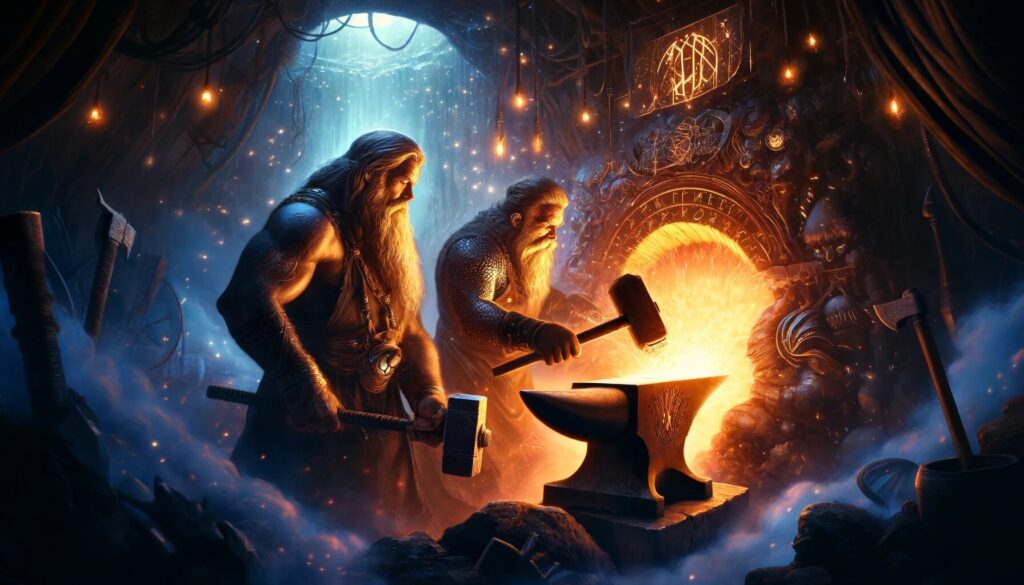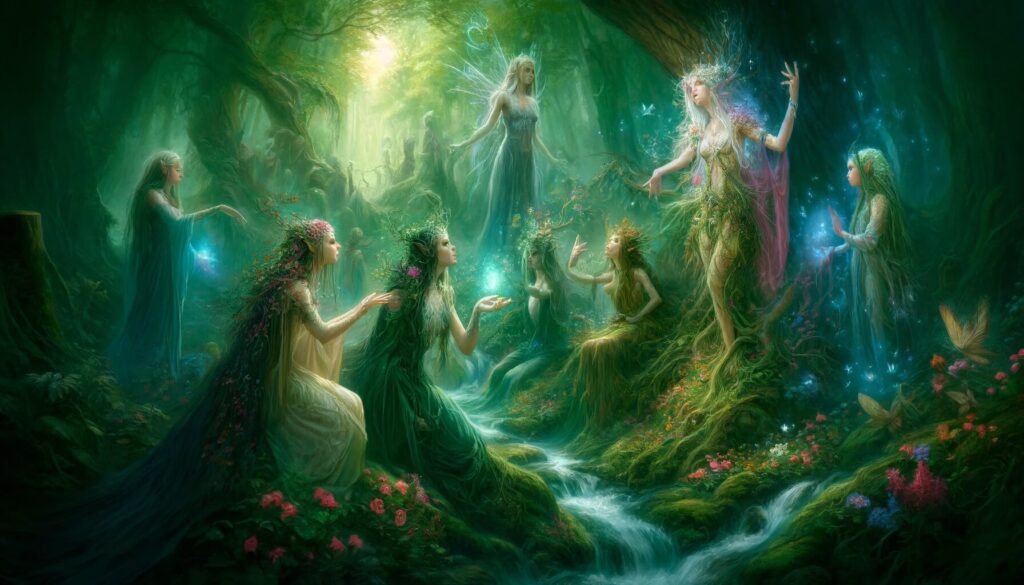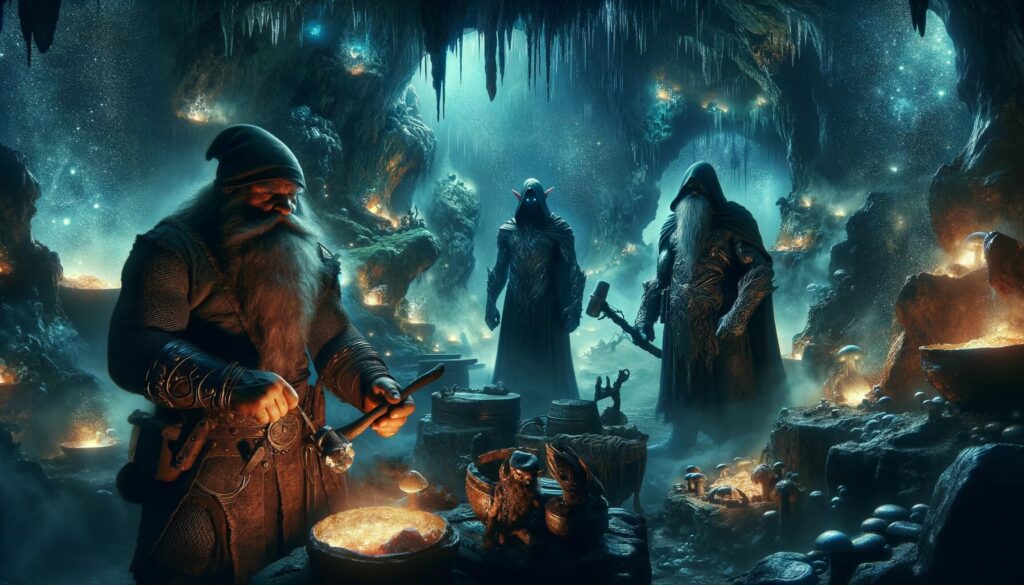Creatures in Norse mythology, Dwarves, Elves, Norse Mythology
Mystic Craftsmen: The Dwarves and Svartalfar in Norse Mythology
Delve into the fascinating world of Norse mythology and explore the elusive figures of dwarves and svartalfar, commonly known as dark elves. These subterranean beings have left an indelible mark in ancient sagas and continue to captivate our imagination. From their origins and role in Norse tales to their significance in Norse culture, this article unravels the mystique surrounding these intriguing creatures.
Who Were the Dwarves in Norse Mythology?
The dwarves play a significant role in Norse mythology, being known as skilled craftsmen and subterranean beings, with characters like Austri and Vestri embodying these qualities. Let’s explore the origins and role of dwarves in Old Norse tales, as well as their connection to dark elves and notable figures in Norse myths and sagas.
Origins and Role of Dwarves in Old Norse Tales
In Norse mythology, the dwarves are believed to have originated from the flesh of Ymir, the first being in the cosmos. According to the ancient sagas, the gods fashioned the dwarves from Ymir’s remains, imbuing them with a natural proficiency for craftsmanship.
Dwarves were revered for their exceptional skills in metallurgy and stonework. They were known to create extraordinary artifacts, weapons, and treasures for the gods and even shaped the world, specifically crafting the foundation of the earth and the sky, as is told in the story of Sif’s golden hair.
The Connection Between Dwarves and Dark Elves
Dwarves and dark elves share a close bond, often being associated with each other in Norse mythology. Both beings are linked to subterranean realms, dwelling beneath the surface of the earth.
It is believed that dark elves, also known as Svartalfar, are a distinct group of elves closely related to dwarves. Like the dwarves, dark elves possess great skill in craftsmanship and magic, often forging alliances and working alongside the dwarves in their subterranean realms, a camaraderie that reminds one of the tales in the Skáldskaparmál. Their collective presence further emphasizes the connection between these two enigmatic entities.
Notable Dwarves in Norse Myths and Sagas
Several dwarves stand out in Norse myths and sagas, leaving their mark on mythology and folklore. One notable duo is Brokk and Eitri, legendary blacksmiths who crafted Thor’s hammer, Mjölnir, along with other magnificent objects.
The story of Brokk and Eitri showcases the exceptional craftsmanship of the dwarves. Loki challenged them to outperform the Sons of Ivaldi, another group of skilled artisans. Brokk and Eitri succeeded in crafting superior creations, including Mjölnir, which became a crucial weapon for Thor, the god of thunder.
These notable dwarves and their creations exemplify the immense talent and significance of dwarves in Norse mythology, cementing their place as key characters in ancient Norse sagas.

What is the Significance of Elves in Norse Mythology?
In Norse mythology, elves are significant ethereal beings associated with the realms of nature and magic, akin to the descriptions found in the Poetic Edda. They are known for their beauty, grace, and mysterious powers, which influence various aspects of the Norse cosmos.
The Difference Between Light Elves and Dark Elves
Elves in Norse mythology are often categorized into two distinct groups: the light elves and the dark elves, also referred to as black elves in some accounts. Light elves, also known as Ljósálfar, reside in Alfheim, a realm of luminous beauty. They are depicted as luminous beings, radiating light and representing purity and innocence.
On the other hand, dark elves, or Svartálfar, inhabit Svartalfheim, a subterranean realm filled with dark and hidden places, much like the black elves discussed in ancient texts. Dark elves are often associated with craftsmanship and are known for their skill and intricacy in creating powerful and magical objects.
Relationship Between Elves, Dwarves, and Gods
Elves in Norse mythology share a close relationship with both dwarves and gods. They often interact and influence each other’s lives, weaving a complex web of relations as detailed in the Völuspá. Elves are considered close allies of the gods, serving as messengers and guardians of their realms, similar to how Freyr is described in the Poetic Edda. They are also believed to be skilled healers and possess magical abilities.
Additionally, there are fascinating connections between elves and dwarves. Both beings are known for their craftsmanship and are often depicted as master artisans, which is a major theme in stories involving Andvari and Fafnir. Elves often seek out dwarves to commission enchanted weapons or other magical items. This relationship highlights the interdependence and cooperation between these mystical creatures in Norse mythology, echoing themes found in the Poetic Edda.
Elves’ Influence on Human Fate in Norse Beliefs
In Norse beliefs, elves are believed to profoundly influence human fate, a concept explored in the Völuspá. They are seen as spiritual beings connected to mortals’ destinies. It was thought that by establishing a strong bond with elves, humans could gain protection, guidance, and even access to hidden knowledge and magical powers.
Elves were frequently invoked in ancient Norse ceremonies and rituals to ensure favorable outcomes and to seek their assistance in various endeavors. Their influence on human fate reflects the importance of the spiritual realm and the belief in the interconnectedness of all beings in Norse mythology, a concept deeply rooted in the Völuspá.
How Did Dwarves Master the Art of Forging?
In Norse mythology, the dwarves were revered for their exceptional craftsmanship and skill in the art of forging. These legendary dwarven smiths were masters of the forge, creating intricate and powerful weapons and artifacts that have become iconic symbols in Norse lore.
Legendary Dwarven Smiths and Their Creations
Sindri and Brokkr stand out for their extraordinary creations among the famous dwarven smiths in Norse mythology. Sindri and Brokkr were tasked with crafting glorious treasures for the gods, showcasing their exceptional skills and craftsmanship.
One of their most renowned creations is the mighty hammer Mjölnir, forged by Brokkr. This powerful weapon, wielded by Thor, was said to be capable of creating thunderstorms and crushing mountains. Another notable creation was Gungnir, the spear of Odin. This spear never missed its target and held immense power in battle.
The Magical Items Crafted by Dwarves in Norse Lore
Magical items crafted by the dwarves held great significance in Norse mythology. These artifacts possessed extraordinary powers and played crucial roles in the gods’ and heroes’ myths and sagas. Besides Mjölnir and Gungnir, other notable creations include Freyr’s ship Skíðblaðnir, which could sail on land and sea, and Draupnir, Odin’s golden ring that multiplied itself every nine days.
Comparing Dwarven Smiths in Mythology and Modern Literature
The portrayal of dwarven smiths in Norse mythology has influenced their depiction in modern literature, notably in the works of J.R.R. Tolkien. In “The Hobbit” and “The Lord of the Rings,” Tolkien’s dwarves showcase their expertise in forging and craftsmanship, forging powerful weapons and magical items.
The heritage of dwarven smiths in mythology has contributed to the enduring fascination with dwarves in modern literature, where their mastery of forging continues to captivate readers and audiences alike.
Why Were Dwarves and Elves Revered in Norse Culture?
Throughout Norse culture, dwarves and elves held a position of great reverence and admiration, a sentiment echoed in the Skáldskaparmál. Their significance stemmed from their remarkable craftsmanship, profound symbolism, and connection to the gods. Let’s delve deeper into the reasons behind their veneration.
The Symbolic Meanings Associated with Dwarves and Elves
Dwarves and elves in Norse mythology are imbued with profound symbolic meanings. Dwarves symbolize craftsmanship and resourcefulness with their exceptional skill in forging weapons and artifacts. They embody the power of creation and the ability to shape the physical world. Elves, on the other hand, are often associated with nature, magic, and hidden knowledge. They represent ethereal beauty, wisdom, and a deep connection to the natural world, ideals that are highly regarded in the Poetic Edda.

The Influence of Norse Dwarves and Elves in Later Folklore
The influence of Norse dwarves and elves extends far beyond their original mythology. These mythical beings have left an indelible mark on folklore and popular culture. Their appearances in fairy tales and fantasy literature continue to captivate audiences worldwide. The reverence for dwarves and elves can be seen in the portrayal of characters such as Snow White’s seven dwarves and J.R.R. Tolkien’s depiction of dwarves and elves in “The Hobbit” and “The Lord of the Rings.” The qualities and characteristics attributed to these mythical creatures have seeped into the collective imagination, shaping our perception of their enduring significance.
Relation Between Norse Dwarves and Creatures in Other Mythologies
The influence of Norse dwarves can also be traced to other mythologies. For instance, Germanic mythology features its version of dwarves, drawing from the Norse tradition. Similarly, the svartálfar of Icelandic folklore share similarities with the Norse concept of dwarves. These connections reveal the wide-reaching impact of Norse mythology on the development of mythological creatures in different cultures.
Therefore, the reverence for dwarves and elves in Norse culture stems from their exceptional craftsmanship, profound symbolism, and connection to the gods. Their influence extends into various forms of folklore and other mythologies, establishing them as enduring and cherished figures in the realm of mythology.
Conclusion
In conclusion, our exploration of dwarves and svartalfar in Norse mythology has revealed fascinating insights into the rich tapestry of ancient sagas and legends. These subterranean beings, revered for their craftsmanship and connection to the gods, hold a significant place in Norse culture.
The origins of dwarves, created from the flesh of Ymir, the first being in the cosmos, highlight their unique position in Norse mythology. Alongside them, the dark elves, or svartalfar, share a close association with subterranean realms and skilled craftsmanship.
Dwarves and elves, both light and dark, have exerted a profound influence on Norse beliefs. They were believed to shape the destinies of mortals, weaving a web of magic and hidden knowledge reminiscent of the narratives in the Völuspá. Their mastery of the art of forging, showcased in legendary weapons and artifacts, demonstrates their unparalleled craftsmanship.
These mythical creatures continue to captivate imaginations and inspire tales in popular culture. From J.R.R. Tolkien’s depiction of dwarves in “The Hobbit” and “The Lord of the Rings” to their appearances in other mythologies, dwarves, and svartalfar have left an indelible mark on the world of storytelling.

